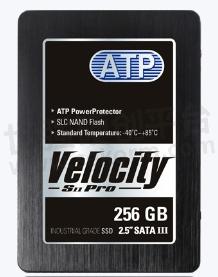SSD Endurance: Challenges and Solutions




Solid state drives (SSDs) are faster and ideal for rough and rugged applications, but one thing that seems to deter those who are considering the big switch from mechanical HDDs is that SSDs can be written to for only a limited number of times. At the end of the SSD's usage life, the data may be corrupted or the device may be rendered unusable if measures are not proactively taken to manage their life span.

How Flash Memory Wears Out
An SSD is made up of NAND flash memory cells. A cell is essentially a metal-oxide-semiconductor (MOS) transistor with a floating gate that can retain or store data persistently – data stays there even if there is no power to the SSD. Each time data is written (programming), electrons are trapped in the transistor. When data is removed (erasing), electrons are taken off. Electrons go in and out through the cell's tunnel oxide. Each program/erase (P/E) is one cycle and every cycle of electrons going in and outwears the tunnel oxide. This is how the flash memory cell wears out.
In this article, we will look at some factors affecting SSD life expectancy and how these can be addressed to manage SSD endurance.
Garbage Collection and Write Amplification
Unlike a hard disk drive, SSDs have no mechanical parts and therefore read, write, and erase data differently. A flash cell is made up of pages, and several pages make up a block. Data is written on a page level, but erasing data is done on the block level.
If the host wants to write new data to a used block, pages containing valid data have to be copied to an empty block, and the previous block has to be completely erased in order for that block to be usable again. This process is called garbage collection. It takes several steps:
All pages with valid data are copied to an empty block.
The flash controller updates the logical block address (LBA) with the new location.
Pages with stale data marked for deletion remain in the old location. The whole block is then erased and added to the free block pool.
New data can now be written on an available empty block.
Because of the extra processes that the controller performs, a phenomenon called write amplification occurs, where the actual amount of physical data written to flash memory becomes larger (amplified) compared with the amount of logical data written by the host. The numerical value, expressed as write amplification index (WAI) or write amplification factor (WAF), is calculated as follows:
Data are written to flash memory / Data from the host = WAI/WAF
Ideally, if the host wants to write 1 MB of data, the SSD should write 1 MB; in this case, WAI is "1." This happens rarely due to the nature of flash memory, and the SSD ends up writing more data than originally intended. This physical act of moving data several times can cause the insulator layer of tunnel oxide to degrade or wear over time. The ability to erase slows down. When a block fails to erase, a spare block is used. Eventually, spares run out, and the SSD fails.
Solutions
TRIM Command. SSDs typically cannot detect which pages contain data marked for deletion, causing them to erase and rewrite entire blocks during the garbage collection process. The TRIM command allows the host operating system to inform the SSD about the location of stale data (marked for deletion). The SSD then accesses the stale data and immediately wipes it out. With the TRIM command, the SSD controller can perform garbage collection on a page level instead of managing whole blocks, thereby reducing WAI and increasing SSD endurance. ATP SSDs support the TRIM function to ensure optimum performance and better endurance. Additionally, ATP SSDs perform background garbage collection, executing the process from time to time even without new write commands to clean up the drive without slowing down write performance.
Over-Provisioning. Over-provisioned (OP) space is space that cannot be used or accessed by the user. It is dedicated to controller functions like garbage collection and TRIM. OP percentage is inversely proportional to WAI; as such, higher OP lowers WAI, decreases drive degradation, and extends the SSD life span. ATP's Dynamic OP solution gives users the freedom to configure the OP according to the actual workloads. Using simple software, OP can be set to 7%, 14%, 28%, 50%, or more in order to optimize performance, endurance, and cost. Down the road, enterprises benefit from more efficient performance and less frequent disk replacements.
Wear Leveling. Wear leveling involves evenly distributing P/E cycles to available cells to avoid overusing certain blocks. Frequently writing to or erasing the same blocks leads to more bad blocks, eventually wearing out the SSD. The ATP Advanced Wear Leveling technology combines both dynamic and static wear leveling techniques. A RAM register on the flash controller records the erase count of all blocks to identify which ones are frequently or seldom used. Data in frequently used blocks are swapped to the seldom-used blocks to even out the erase count and effectively wear level the entire SSD.
Uncorrectable/Unrecoverable Bit Error Rate (UBER)
UBER is a measure of the data corruption rate referring to the percentage of bits with errors in relation to the total number of read bits. Bit errors increase as P/E cycles increase. Error-correcting code mechanisms in the controller typically detect and fix these errors automatically, but when errors reach the ECC capability threshold, the SSD is bound to fail.
Solutions
ATP AutoRefresh and Dynamic Data Refresh technologies check for both error bits and read counts in frequently read as well as seldom-read areas.
AutoRefresh Technology improves the data integrity of read-only areas by monitoring the error bit level and read counts in every read operation. It detects when the read count is about to exceed the threshold and before the limit is reached, data in the affected block is copied to a healthy block, thus preventing the controller from reading blocks with too many error bits and averting uncorrectable data damage.
Dynamic Data Refresh Technology reduces the risks of read disturbance and sustains data integrity in seldom-accessed areas. Read disturbance happens when frequent reading of a cell causes adjacent cells to change or be programmed. Dynamic Data Refresh runs automatically in the background, sequentially scanning the user area flag record while the SSD is free from host commands, thus keeping data safely stored without affecting the read/write operation.
Imminent SSD End of Life
Flashwear is a reality, and SSDs are bound to fail at one point in the future. Being unprepared for this unavoidable event can lead to catastrophic data loss, expensive equipment replacements, and more. By effectively monitoring and managing the SSD life span, users can take contingency measures and make the necessary replacements before the SSD wears out.
Solutions
ATP SD Life Monitor / S.M.A.R.T. (Self-Monitoring, Analysis, and Reporting Technology) provides a friendly interface for monitoring various indicators of drive reliability and other attributes. Armed with this vital information, users can plan ahead and replace SSDs before they wear out, saving data and precious financial resources.
Conclusion
Despite the reality of flash wear-out, technological advancements in firmware and design enable current flash storage products to last and perform reliably for longer periods of time. Through careful management using available tools and solutions, your SSD will serve you well for many years. For more information about ATP's high-endurance SSDs, visit the ATP website or contact an ATP Representative or Distributor in your area.
- |
- +1 赞 0
- 收藏
- 评论 0
本文由涂抹转载自ATP Blogs,原文标题为:SSD Endurance: Challenges and Solutions,本站所有转载文章系出于传递更多信息之目的,且明确注明来源,不希望被转载的媒体或个人可与我们联系,我们将立即进行删除处理。
相关推荐
The Important Role of DRAM in the Internet of Things
DRAM as a Key Component in Data Processing. ATP DRAM products are capable of meeting the escalating memory requirements of the IoT/IIoT age. Designed, tested, validated and built to exacting industry standards, these modules are built to perform dependably for a long time, delivering trustworthy performance that translates to high return on investment and low total cost of ownership.
How Temperature Affects Data Retention for SSDs
How can the integrity of data written on the flash drive be guaranteed at high operating or storage temperatures?
Ensuring NAND Flash and Data Integrity of Dashcam Memory Cards (Part 2)
In this article, ATP presents three most frequent causes of data corruption, their fixes, and an enhanced analysis approach based on NAND technology and user behaviours. New S650/S750 Series SD meet the high endurance, low latency, built-to-last data storage requirements of dashcams.
SMART(世迈科技)DuraFlash™闪存产品选型指南
目录- Company Portfolio/Products Applications Flash Storage Product Introduction 2.5” SATA M.2 SATA mSATA Slim SATA M.2 PCIe NVMe U.2 PCIe NVMe EDSFF / U.2 PCIe NVMe (Enterprise and Data Center SSDs) BGA eMMC 5.1 Memory Cards CF Cards/CFast Cards eUSB Flash Drives/USB Flash Drives RUGGED SSD LINE-UP
型号- N200,R800,RU350,SP2800,S5E,RU150,T5E,M4,R800V,BGAE440,S1800,BGAE240,RD130M,ME2,M1HC,H9 CF,M1400,HU250E,M4P,T5EN,T5PFL,RU150E,N200V,T5PF,RD230M,MDC7000,XL+,RD230
PCIe® Gen 3 NVMe M.2 2280 / 2242 / 2230 SSD The Global Leader in Specialized Storage and Memory Solutions
型号- FT960GP38AG8BPC,N750PI,FT480GP38ANDBFC,FT120GP38AG8BPC,FT480GP38AG8BPC,FT480GP34ANDBFC,FT960GP38AG8BPI,FT240GP38AG8BPC,FT120GP38ANDBFC,N700PC,FT240GP38AG8BPI,FT120GP38AG8BPI,N600SC,N650SI,N600VI,FT960GP34ANDBFC,N700PI,FT240GP38ANDBFC,N600SI,FT120GP34ANDBFC,N650SC,FT240GP34ANDBFC,N600VC,FT480GP38AG8BPI
PCIe® Gen 3 NVMe M.2 2280 / 2242 / 2230 SSD
型号- FT960GP38AG8BPC,N750PI,FT480GP38ANDBFC,FT120GP38AG8BPC,FT480GP38AG8BPC,FT480GP34ANDBFC,FT960GP38AG8BPI,FT240GP38AG8BPC,FT120GP38ANDBFC,N700PC,FT240GP38AG8BPI,FT120GP38AG8BPI,N600SC,N650SI,N600VI,FT960GP34ANDBFC,N700PI,FT240GP38ANDBFC,N600SI,FT120GP34ANDBFC,N650SC,FT240GP34ANDBFC,N600VC,FT480GP38AG8BPI
Bringing 3D TLC NAND Flash Endurance and Reliability Closer to SLC/MLC
The advent of 3D NAND technology allowed for more relaxed lithography and broke planar NAND limitations. By stacking cells vertically, 3D NAND flash increased drive reliability and endurance. ATP breaks new ground with its new 3D TLC-based SATA SSDs.
ATP Launches Its Tiniest PCIe Gen3 x4 NVMe™ SSDs in M.2 Type 1620 HSBGA Package
ATP Electronics, the global leader in specialized storage and memory solutions, has announced the launch of its tiniest NVMe flash storage offering: the N700 Series PCIe® Gen3 x4 NVMe™ solid state drives (SSDs, which are available as M.2 Type 1620 heatsink ball-grid array (HSBGA) package.
SMART Modular Introduces Ruggedized, High-Speed, High Capacity, High Security T6EN SSDs for Aerospace, Defense and Industrial Applications
SMART Modular Technologies announced its new ruggedized T6EN PCIe/NVMe flash drives for aerospace, defense, and industrial applications. This new family of SSDs is available in U.2, E1.S and M.2 2280 form factors, enabling flexibility for end users based on their specific application and configuration needs.
ATP‘s Power Loss Protection Just Got Smarter with MCU-based SSD Design
ATP customers want constant assurance that power loss events will not cause massive downtime or lost data that could affect business operations and lead to higher operating costs. The MCU intelligently monitors sudden power failure conditions from a glitch to a surge or a complete outage...
PCIe® Gen 4 NVMe M.2 2280 SSD The Global Leader in Specialized Storage and Memory Solutions
型号- FT3T84P48APHBFC,FT1T92P48APHBYC,FT240GP48APHBPC,FT240GP48APHBPI,FT960GP48APHBYI,N651SI,AF960GSTJA-HBAXX,FT1T92P48APHBPI,N601VI,FT480GP48APHBFI,FT3T84P48APHBFI,FT1T92P48APHBPC,FT480GP48APHBFC,FT960GP48APHBYC,N651SC,N601VC,FT960GP48APHBFC,FT240GP48APHBSC,FT960GP48APHBFI,FT480GP48APHBYI,FT240GP48APHBSI,AF240GSTJA-HBBXX,AF1T92STJA-HBBXX,AF480GSTJA-HBBXX,FT1T92P48APHBYI,FT480GP48APHBPI,FT480GP48APHBPC,FT1T92P48APHBFC,FT960GP48APHBSI,FT1T92P48APHBFI,FT960GP48APHBSC,FT3T84P48APHBYC,FT240GP48APHBFC,FT480GP48APHBYC,AF960GSTJA-HBBXX,FT240GP48APHBFI,FT240GP48APHBYC,FT240GP48APHBYI,FT480GP48APHBSI,N751PI,FT480GP48APHBSC,FT3T84P48APHBYI,FT960GP48APHBPI,N601SC,FT1T92P48APHBSI,AF1T92STJA-HBAXX,AF240GSTJA-HBAXX,FT960GP48APHBPC,AF480GSTJA-HBAXX,FT1T92P48APHBSC
DRAM-less Value Line SSDs Available in I-Temp/C-Temp Operable Models
型号- A600VC SERIES,N600VI,A600VI,A600VI SERIES,A600VC,N600VC SERIES,N600VC,N600VI SERIES
The ATP Gym and Coach System: Exercising SSDs to Ensure Total Fitness
With the Gym and Coach system, ATP has dramatically improved RDT and the initialization process for functional test details. By making industrial SSDs undergo a lot of “painful” exercises through stringent testing, ATP makes sure that customers have everything to gain by receiving the most robust, reliable and enduring flash storage products for their applications.
A750/A650, N750/N650 Series: New-Generation 3D TLC SSDs Deliver Near-SLC/MLC Endurance
型号- N750,A750PI,N750 MODEL,N750PI,N650 MODEL,N650,A650 SERIES,N650 SERIES,A750 SERIES,A650,A750,N650SI,N750 SERIES,N650SC,A650SI,A650SC
The Benefits of Pseudo SLC (pSLC) Flash with Customizable Endurance
ATP’s pSLC-based embedded SSDs with customizable endurance offer the optimum balance cost-performance-endurance balance. They address the diversity of use cases across different industries, allowing ATP to tailor-fit according to different workloads and applications.
电子商城
现货市场
服务
可烧录MCU/MPU,EPROM,EEPROM,FLASH,Nand Flash, PLD/CPLD,SD Card,TF Card, CF Card,eMMC Card,eMMC,MoviNand, OneNand等各类型IC,IC封装:DIP/SDIP/SOP/MSOP/QSOP/SSOP/TSOP/TSSOP/PLCC/QFP/QFN/MLP/MLF/BGA/CSP/SOT/DFN.
最小起订量: 1 提交需求>
拥有IC烧录机20余款,100余台设备,可以烧录各种封装的IC;可烧录MCU、FLASH、EMMC、NAND FLASH、EPROM等各类型芯片,支持WIFI/BT模组PCBA烧录、测试。
最小起订量: 1 提交需求>








































































































































































































登录 | 立即注册
提交评论